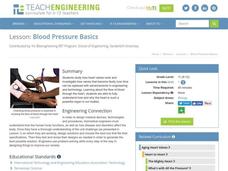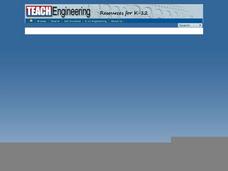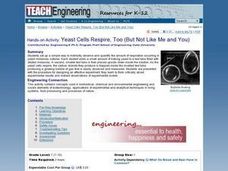Curated OER
Biotechnology: Drug Delivery and Diffusion
Students discover advances in biomedical technology such as transdermal delivery and other non-invasive procedures. In lab activities, they examine how medication is given and how molecules travel, observe electrophoresis, and conduct...
Curated OER
How To Make Yeast Cells Thrive
Students set up and run the experiments they designed in the instructional activity, 'Population Growth in Yeasts,' using simple yeast-molasses cultures in test tubes. They demonstrate understanding that several environmental factors can...
Curated OER
Design a Paraplegic Equestrian Saddle
Studnets develop a new equestrian saddle for a paraplegic rider.
Curated OER
Seeing and Feeling Sound Vibrations
Groups rotate through a series of stations and work with a partner to observe sound waves. Children describe sound in terms of pitch, volume, and frequency. To apply their new knowledge, the class considers how these observations can...
Teach Engineering
Blood Pressure Basics
Under pressure! The second lesson of the series introduces the class to blood pressure and the impact of high blood pressure on the cardiovascular system. It helps learners make the connection between blood pressure and how the heart...
Teach Engineering
How Antibiotics Work
Take two pills and call me in the morning. The first lesson in a short unit of four introduces class members to delivery methods of medicines. The instruction introduces the question of which delivery method is best to get you feeling...
Teach Engineering
Bone Mineral Density Math and Beer's Law
Hop into a resource on Beer's Law. A PowerPoint presentation introduces Beer's law as part of calculating bone density from X-ray images in the sixth lesson in the series of seven. Individuals work on practice problems with this law and...
Teach Engineering
May the Magnetic Force Be with You
Class members use mathematics in order to better understand magnetic forces and their interaction on charged particles. After a demonstration of the interaction between a magnet and an electron beam using a CRT computer monitor, learners...
Curated OER
Detecting Breast Cancer
Learners develop a painless means for identifying cancerous tumors. In this imaging lesson plan students list the information that may be needed to answer the problem.
Curated OER
The Strongest Pump of All
Young scholars examine how the heart functions and the concept of how electrical currents can affect muscle contractions. In this cardiovascular lesson students identify P, QRS and T complexes.
Curated OER
Protecting the Mummified Troll
Students develop an invisible security system to protect a mummified troll. In this security system lesson students view a portion of Mythbusters and begin their challenge.
Curated OER
Learning Light's Properties
Students examine the properties of light and the behavior of light during interference. In this electromagnetics instructional activity students explain behaviors of light.
Teach Engineering
Properties of Mixtures vs. Solutions: Mix It Up!
Now it becomes crystal clear why the unit is called Mixtures and Solutions. The fifth installment of a six-part unit explores mixtures and solutions. After viewing a demonstration on mixing pebbles with water, salt with water, and...
Teach Engineering
Alloy Advantage
Mix it up by using an intriguing resource that teaches young metallurgists that alloys are a metal mixture. They learn about the advantages of using alloys over pure metals and investigate titanium alloys as an example to finish the...
Curated OER
Silly Semi-Solids
Students create a polymer out of glue, water, and borax. They discuss the resulting substance and perform several experiments with it.
Curated OER
Our Amazing Skeleton
Students study the skeleton, about the number of and types of bones in the body, and how outer space affects astronauts' bones. They discover how to take care of their bones here on Earth to prevent osteoporosis, or, weakening of the...
Curated OER
Endocrine Excitement!
Students are divided into a group of hormones and a group of receptors. The hormones have to find their matching receptors, and the pair, once matched, perform a given action. This activity helps students examine the specificity of...
Curated OER
Biomechanics of Joints
High schoolers investigate range of motion in human joints and the mechanical devices they emulate. They construct a human arm model with three joints which emulate the wrist, elbow and shoulder.
Curated OER
Seeing the World Through A Different Lens
Students participate in activities in which they model different disabilities. They discuss their experiences as a class. They work together in groups to discuss how to improve an adaptive device.
Curated OER
Biomechanics of Joints
Students examine the range of motion of your knee, wrist and shoulder and observe that these body parts act like different types of mechanical joints.
Curated OER
TE Activity: Yeast Cells Respire, Too (But Not Like Me and You)
Student observe and quantify the respiration that occurs in yeast-molasses cultures. They complete an effective experiment in order to examine how to think critically about the results.























